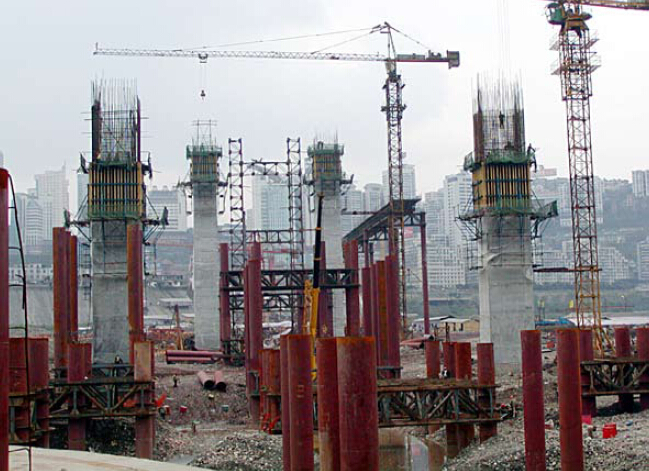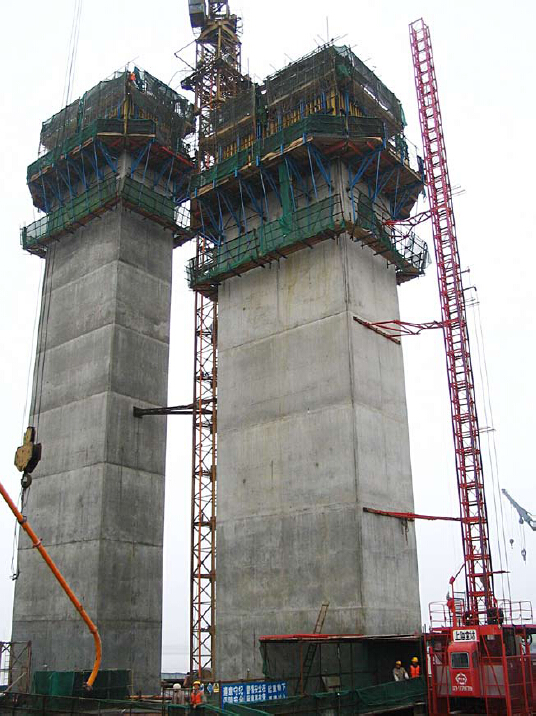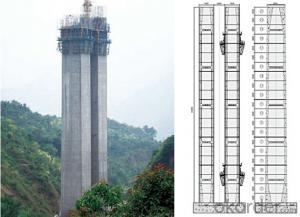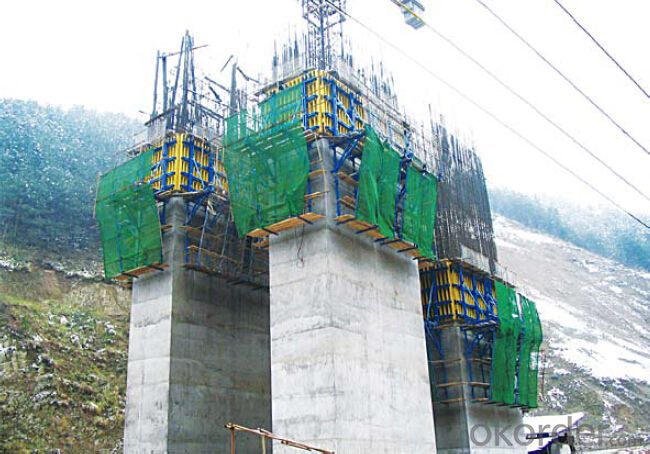Climbing bracket CB-240 for formwork and scaffolding system
- Loading Port:
- Tianjin
- Payment Terms:
- TT OR LC
- Min Order Qty:
- 50 m²
- Supply Capability:
- 1000 m²/month
OKorder Service Pledge
OKorder Financial Service
You Might Also Like
Climbing Bracket CB240 & CB210
They are framework brackets for supporting large-area wall formwork.
Typical applications for the CB240&CB210 are pier and column/shear wall/core walll/ in the
building.
CB210 has smaller size than CB240, it will be cost effective in some condition.
Characteristics:
◆ High bearing capacity
The high loading capacity of the brackets allow very large scaffold units. This saves the number
anchor points required as well as reducing climbing times.
◆ Simple moving procedure by crane
Through the strong connection of formwork together with the climbing scaffold, both can be moved
as a single climbing unit by crane. Thus valuable time-savings can be achieved.
◆ Fast striking process without a crane
With the retrusive set, large formwork elements can also be retracted quickly and a minimum of
effort.
◆ Safe with work platform
The platforms have assembled firmly with bracket and will be climbing together, without scaffolding
but can work safely in spite of your high location.


- Q: How does steel formwork handle formwork stripping and repositioning?
- Steel formwork is an option that is highly durable and versatile for the handling of formwork stripping and repositioning. It is designed to withstand the pressure exerted during the concrete pouring process and can easily manage the removal of the formwork once the concrete has set. When it comes to the removal of formwork, steel formwork offers several advantages. Firstly, it ensures a high-quality end result by providing a smooth surface finish to the concrete. The steel panels are typically coated with a protective layer, preventing concrete from sticking to the formwork and making stripping easier. The steel formwork system is engineered to facilitate quick and efficient formwork removal. This is achieved through the use of various mechanisms such as wedge clamps, pins, or hooks, which securely hold the formwork panels in place during the pouring process. Once the concrete has gained sufficient strength, these mechanisms can be easily released, allowing for smooth and effortless stripping of the formwork. Furthermore, steel formwork can be easily repositioned and reused for multiple construction projects. The modular design of steel panels allows for flexibility in adjusting the formwork to different dimensions and shapes. This reusability significantly reduces the overall cost of formwork, making it a cost-effective solution for construction projects. In addition, steel formwork provides excellent strength and stability, ensuring the integrity of the structure throughout the formwork stripping and repositioning process. This is particularly crucial in high-rise or complex structures where the formwork must withstand significant loads and pressures. In conclusion, steel formwork is a dependable and efficient choice for handling formwork stripping and repositioning. Its durability, ease of use, and adaptability make it the preferred option for construction projects of various sizes and complexities.
- Q: What are the common quality control measures for steel formwork systems?
- Some common quality control measures for steel formwork systems include conducting regular inspections of the formwork components for any signs of damage or wear, verifying the accuracy of dimensions and alignments, ensuring proper installation and alignment of formwork components, conducting load tests to ensure the formwork system can withstand the required loads, and monitoring the concrete pouring process to ensure proper placement and consolidation. Additionally, adherence to relevant industry standards and guidelines, as well as proper documentation and record-keeping, are also important quality control measures for steel formwork systems.
- Q: How does steel formwork accommodate for different concrete curing temperatures?
- Steel formwork is able to accommodate for different concrete curing temperatures due to its high thermal conductivity. This means that the steel transfers heat more efficiently, allowing for a faster and more uniform distribution of heat throughout the formwork. As a result, the concrete cures at a more consistent temperature, reducing the risk of uneven curing and potential structural issues. Additionally, steel formwork provides better insulation, preventing excessive heat loss or gain during the curing process, which further helps to maintain the desired temperature conditions.
- Q: Can steel formwork be used for decorative concrete finishes?
- Yes, steel formwork can be used for decorative concrete finishes. It provides sturdy support and precise shaping, allowing for intricate designs and smooth finishes in decorative concrete applications.
- Q: Are all steel plates used for beam slab prefabrication
- Prefabricated components according to the number of times to determine the turnover, the same specifications of the components to reach more than 10, the general use of stereotypes steel template, the specification of the component is less, the general use of steel or steel formwork formwork
- Q: What are the considerations when selecting the thickness of steel formwork?
- There are several important factors to consider when choosing the thickness of steel formwork. To begin with, the load-bearing capacity of the formwork needs to be taken into account. The steel should be thick enough to withstand the weight of the concrete and any additional loads that may be applied during construction. This includes considering the height and pressure of the concrete pour, as well as any equipment or workers on the formwork. Additionally, it is important to consider the durability and longevity of the steel formwork. The thickness should be chosen to ensure that the formwork can withstand the wear and tear of construction activities and any potential exposure to environmental factors such as corrosion or extreme weather conditions. Thicker steel provides greater strength and resistance to these factors. The desired surface finish of the concrete is another consideration. Thinner steel formwork may result in a smoother surface finish, while thicker formwork may create a more textured or patterned finish. The thickness should be selected based on the desired aesthetic outcome of the project. Cost is also a significant factor to consider. Thicker steel is generally more expensive than thinner steel, so it is important to find a balance between the required strength and the available budget. In some cases, using a combination of different thicknesses may be a cost-effective solution. Finally, the ease of handling and installation should be taken into account. Thicker steel formwork can be heavier and more challenging to handle, so it is important to consider the available equipment and labor resources. The thickness should be chosen in a way that ensures safe and efficient installation. In conclusion, when choosing the thickness of steel formwork, it is important to consider the load-bearing capacity, durability, desired surface finish, cost, and ease of handling. By carefully evaluating these factors, the most suitable thickness can be selected for the specific construction project.
- Q: How does steel formwork affect the overall cost-effectiveness of a construction project?
- Steel formwork can significantly enhance the cost-effectiveness of a construction project due to its durability and reusability. Its strength allows for multiple reuses, reducing the need for frequent replacements and thereby decreasing material and labor costs. Moreover, steel formwork facilitates faster construction processes, minimizing labor expenses and project duration. Additionally, its higher quality finish reduces the need for additional finishing work, resulting in further cost savings. Overall, steel formwork's longevity, efficiency, and reduced maintenance costs make it a cost-effective choice for construction projects.
- Q: How does steel formwork impact the overall project execution?
- The overall project execution is significantly influenced by steel formwork in several ways. Firstly, steel formwork is renowned for its durability and strength, making it suitable for various construction projects. Its robustness allows for multiple reuses, minimizing the need for frequent replacements and reducing project costs. Moreover, steel formwork ensures a high level of accuracy and precision in shaping and sizing concrete structures. This guarantees that the final product meets design specifications and minimizes potential errors or defects. The ability to achieve precise and consistent results helps streamline the construction process, saving time and effort. Additionally, steel formwork provides excellent support and stability during concrete pouring and curing. Its rigid structure prevents deformation or displacement, ensuring even and secure concrete setting. This results in a structurally sound and stable finished product, enhancing overall project quality. Furthermore, steel formwork is versatile and adaptable, allowing efficient customization to meet specific project requirements. It can be easily modified or adjusted to accommodate various shapes, sizes, and complexities of concrete structures. This flexibility enables contractors to work on projects with different design specifications, reducing the need for multiple formwork systems and improving project efficiency. Lastly, steel formwork enhances safety on construction sites. Its sturdy construction provides a stable working platform for workers, reducing the risk of accidents or injuries. Additionally, the use of steel formwork often requires fewer construction joints, creating a smoother and safer working environment. In conclusion, steel formwork plays a crucial role in project execution, providing durability, accuracy, stability, versatility, and safety. Its impact extends beyond the construction phase, contributing to the long-term quality and success of the project.
- Q: Can steel formwork be used for swimming pool construction?
- Swimming pool construction can utilize steel formwork, which is a versatile and durable choice commonly employed in the construction industry for various purposes. Steel formwork offers numerous benefits, such as high strength, stability, and reusability, making it ideal for constructing swimming pool walls, floors, and other structures. By employing steel formwork, a smooth and precise finish is achieved, ensuring uniformity in the appearance of swimming pool walls and floors. It can withstand the water pressure, ensuring the structural integrity of the pool. Furthermore, steel formwork is easily assembled and disassembled, facilitating efficient construction and maintenance. Additionally, steel formwork is highly adaptable and can be customized to meet specific design requirements. It accommodates the construction of various shapes and sizes of swimming pools, including both in-ground and above-ground options. This adaptability makes steel formwork the preferred choice for swimming pool construction projects. Nevertheless, when employing steel formwork for swimming pool construction, certain factors must be considered. Proper waterproofing measures must be implemented to prevent water leakage and corrosion of the steel. Adequate reinforcement and support are also necessary to ensure the stability and durability of the pool structure. In conclusion, steel formwork is a suitable option for swimming pool construction due to its strength, durability, and versatility. Proper usage, in combination with appropriate waterproofing and reinforcement measures, can result in a robust and visually pleasing swimming pool.
- Q: Can steel formwork be used for airport runway construction?
- Yes, steel formwork can be used for airport runway construction. Steel formwork is a durable and versatile option that can withstand heavy loads and provide a smooth surface for concrete placement. It is commonly used in large-scale construction projects like airports due to its strength, stability, and ability to be reused multiple times, making it an ideal choice for runway construction.
Send your message to us
Climbing bracket CB-240 for formwork and scaffolding system
- Loading Port:
- Tianjin
- Payment Terms:
- TT OR LC
- Min Order Qty:
- 50 m²
- Supply Capability:
- 1000 m²/month
OKorder Service Pledge
OKorder Financial Service
Similar products
Hot products
Hot Searches


















